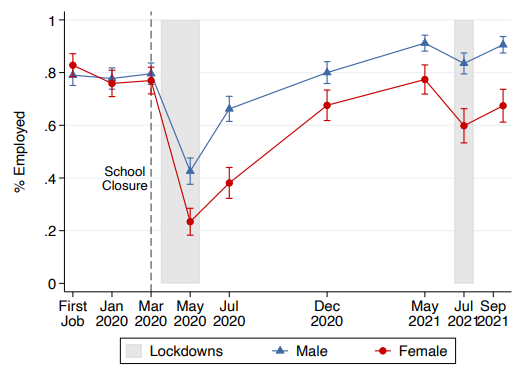Gender Gaps: Back and Here to Stay? Evidence from Skilled Ugandan workers during COVID-19
by Livia Alfonsi, Mary Namubiru and Sara Spaziani

Abstract: We investigate gender disparities in the effect of COVID-19 on the labor market outcomes of skilled Ugandan workers. Leveraging a high-frequency panel dataset, we find that the lockdowns imposed in Uganda reduced employment by 69% for women and by 45% for men, generating a previously nonexistent gender gap of 20 p.p. Eighteen months after the onset of the pandemic, the gap persisted: while men quickly recovered their pre-pandemic career trajectories, 10% of the previously employed women remained jobless and another 35% remained occasionally employed. Additionally, the lockdowns shifted female workers from wage-employment to self-employment, relocated them into agriculture and other unskilled sectors misaligned with their skill sets, and widened the gender pay gap. Pre-pandemic sorting of women into economic sectors subject to the strongest restrictions and childcare responsibilities induced by schools’ prolonged closure only explain up to 65\% of the employment gap.
Topic. We document gender disparities in the effect of COVID-19 on the labor market outcomes of skilled workers in Uganda.
Results. The lockdowns reduced employment by 69% for women and by 45% for men, generating a previously nonexistent gender gap of 20 p.p. The gap endured for eighteen months, driven by 35% of previously employed women remaining jobless or occasionally employed. Women's sorting into severely hit economic sectors and childcare responsibilities generated by schools' closure fail to fully explain the emergence and the persistence of the gap. The lockdowns also relocated women into self-employment, agriculture, and other unskilled sectors and widened the gender earnings gap.
Policy considerations. The labor market trajectories of economically empowered women in low-income countries are highly vulnerable to temporary economic shocks, with downstream effects on the countries' productivity and economic growth. Governments, international organizations, and NGOs should prioritize supporting enterprises in female-dominated sectors and women seeking stable employment. Closing the employment gender gap will additionally require identifying the forces behind its unexplained portion, such as employer discrimination or social norms.

